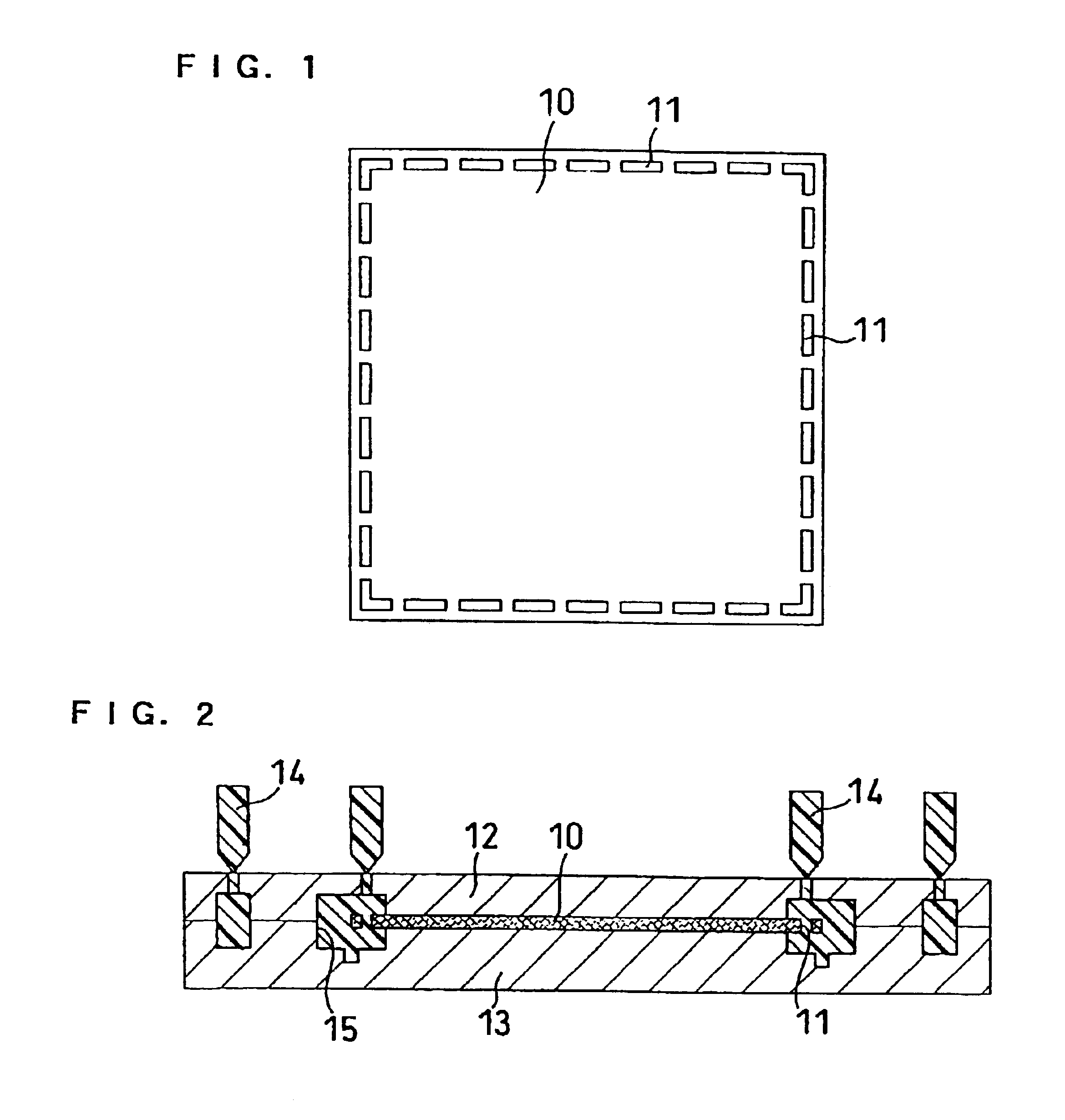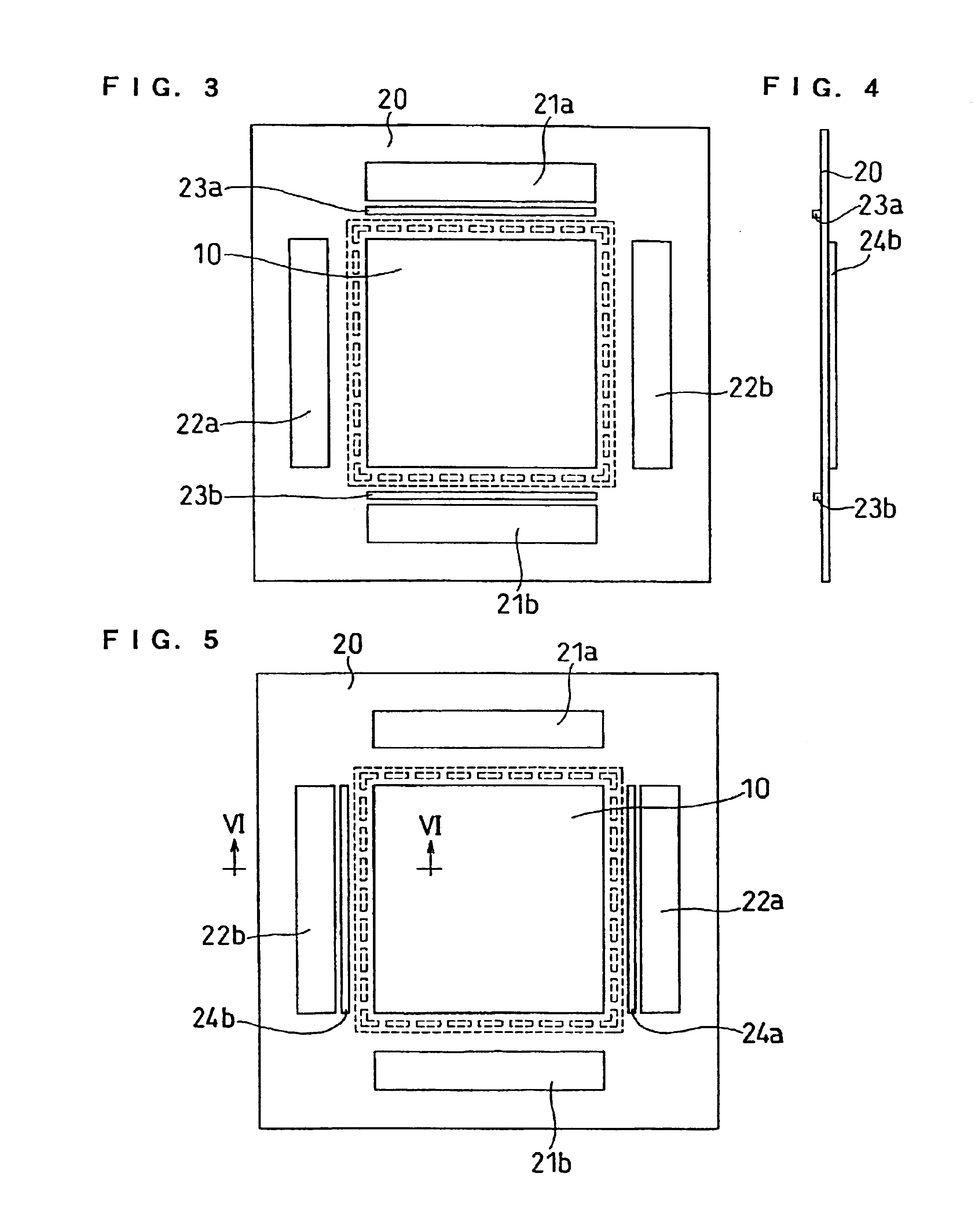High polymer electrolyte fuel cell and electrolyte film-gasket assembly for the fuel cell
a fuel cell and high-polymer technology, applied in the field of solid-phase electrolyte fuel cells, can solve the problems of gasket easily detachable from the electrolyte membrane, gas cross leakage, poor surface activity and no adhesiveness, etc., to achieve high pressure-proof seal, prevent gas leakage, and reduce manufacturing costs
- Summary
- Abstract
- Description
- Claims
- Application Information
AI Technical Summary
Benefits of technology
Problems solved by technology
Method used
Image
Examples
embodiment 1
FIGS. 3 through 6 show an electrolyte membrane-gasket assembly according to this embodiment. This assembly comprises an electrolyte membrane 10, and a gasket 20 joined integrally to the peripheral portion of the electrolyte membrane 10 by injection molding. As illustrated in FIG. 1, formed in the peripheral portion of the electrolyte membrane 10 are a number of through-holes 11. This electrolyte membrane 10 is set in a mold composed of a cavity mold 12 and a core mold 13, and the frame-like gasket 20 is molded on the peripheral portion of the electrolyte membrane 10 by an insert injection molding process in which a melted thermoplastic resin or thermoplastic elastomer is poured into a molded product section 15 from gates 14.
The gasket 20 thus molded comprises a portion covering one surface of the electrolyte membrane 10 and a portion covering the other surface thereof, which are connected to each other through the regularly arranged through-holes 11 in the peripheral portion of the ...
embodiment 2
FIGS. 11 through 13 illustrate an electrolyte membrane-gasket assembly according to this embodiment. Like Embodiment 1, a gasket 40 joined integrally to the electrolyte membrane 10 has an inlet-side manifold aperture 41a and an outlet-side manifold aperture 41b for the fuel gas, and an inlet-side manifold aperture 42a and an outlet-side manifold aperture 42b for the oxidant gas. The gasket 40 further has, on a surface thereof facing the cathode-side conductive separator plate, gas flow channels 45a and 45b for connecting the cathode and the manifold apertures 42a and 42b, respectively, and, on a surface thereof facing the anode-side conductive separator plate, gas flow channels 46a and 46b for connecting the anode and the manifold apertures 41a and 41b, respectively.
FIGS. 14 and 15 show a cell structure using this electrolyte membrane-gasket assembly. An anode 55 has, on a surface thereof that does not face the electrolyte membrane, a gas flow channel 56 connected to the gas flow ch...
embodiment 3
FIGS. 18 through 20 illustrate an MEA of this embodiment, and FIGS. 21 through 23 show a conductive separator plate to be combined with this MEA. Like Embodiment 1, a gasket 60 is integrally joined to the peripheral portion of an electrolyte membrane 100 by injection molding. An anode 75 is joined to one surface of the electrolyte membrane 100 to which the gasket has been joined, while a cathode 77 is connected to the other surface thereof.
The gasket 60 has an inlet-side manifold aperture 61a and an outlet-side manifold apertures 61b for the fuel gas, an inlet-side manifold aperture 62a and an outlet-side manifold aperture 62b for the oxidant gas, and an inlet-side manifold aperture 63a and an outlet-side manifold aperture 63b for cooling water. The gasket 60 has, on the anode-side surface thereof, a rib 64 provided in the peripheral portion, and ribs 64a and 64b for separating the manifold apertures 62a, 63a and manifold apertures 62b, 63b from the anode 75. The rib 64 prevents the...
PUM
| Property | Measurement | Unit |
|---|---|---|
| thick | aaaaa | aaaaa |
| thickness | aaaaa | aaaaa |
| thickness | aaaaa | aaaaa |
Abstract
Description
Claims
Application Information
 Login to View More
Login to View More - R&D
- Intellectual Property
- Life Sciences
- Materials
- Tech Scout
- Unparalleled Data Quality
- Higher Quality Content
- 60% Fewer Hallucinations
Browse by: Latest US Patents, China's latest patents, Technical Efficacy Thesaurus, Application Domain, Technology Topic, Popular Technical Reports.
© 2025 PatSnap. All rights reserved.Legal|Privacy policy|Modern Slavery Act Transparency Statement|Sitemap|About US| Contact US: help@patsnap.com



